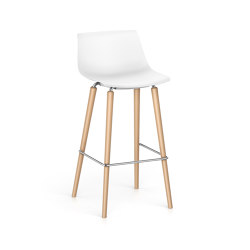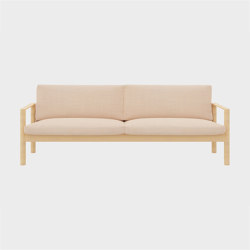Raptor table RT01
Dining tables from Raptor, Designed by Aleksander Pantopulos, Sotyrys Pantopulos
Product description
Concept
Design is a process
The process of creating new qualities can develop new ideas and indicate directions of development, thanks to technology ideas and projects unfeasible not long ago, become a reality. Thanks to technology an evolution of thinking about creation becomes possible, new forms are described by details. Detail is the most important element of a project, detail which elevates and determines the nature and the quality of an object. Concepts of creating new objects thanks to advanced technological solutions both in terms of design / through techniques of creation - describing three-dimensional solids and transferring the design to the real world, as well as the execution and handling show new trends in design.
Evolution of technology makes the inspiration and the processes of creation of new works break frames of design trends. Disappearing technical barriers finally enable projects to be emotional rather than rational, and the process of creation is not limited by any barriers in the implementation. As Philippe Starck said, "no matter how things look, but what emotions they trigger".
The project RT01 table by RAPTOR has been developed, and in fact has evolved over several years. Our main objective was to create a sophisticated, sculptural, biomechanical structure which is a combination of organic elements drawn from biological organisms and purely mechanical technology - something more than a simple piece of functional furniture. The biggest challenge was to combine these opposing trends to create a coherent poetic quality. The project was to be predatory and at the same time beautiful. It was meant to cause excitement, I wanted individual elements to be rather alive than still, as if they had an internal skeleton, its anatomy which would be visible through a transparent shell. The whole, however, was to be solid, rather indestructible - just as a factory machine or a fast motor. However, a biomechanical form having bone seams and tendons connected with visible screws was very difficult to define in the process of creation. It was in opposition to my previous formal assumptions, the concept was based on a parametrically defined morphing, geometrically difficult to describe. However, they were not supposed to be random but rather repetitive in their form, just as organisms – the left side being a reflection of the right, etc. We were looking for methods to define mathematically selected shapes in space. In the process of creation we used modeling on the basis of grids of polygons as well as paths – NURBS which offer good opportunities of turning virtual geometry into actual models - prototypes, which was one of the toughest problems in the process. The first models were, however, carved out of wood by a sculptor. Nevertheless the effect was not satisfactory enough for us so that we used computer modeling until the end.
All ergonomics is based on anatomically defined patterns. Data from numerous of our previously implemented models were input to the proposed geometry, which helped us to obtain a perfect grid for the final version of the project. RT01 table offers multiple possibilities of adjustments of both the height and the angles of inclination; design of individual elements gives the complete body a technological nature of a skeleton. Ultimately the elements were produced as aluminum die-casting, polished or powder coated.
Providing a wide range of possibilities to create modern office as a designer space for work in the Executive Office segment, we have also designed a number of different skins / shells /that allow for its modifications. Each new work of architecture or design is not born independently of any other architecture or other works designed over time. The undeniable fact is that the work of a designer is influenced by architecture previously seen (whether historical or the author's previous work, or the work of other designer authors as seen in magazines). If this is so, and if built architecture is seen as an entity, it can be said that the DNA of every work of architecture passes through the eye to the brain of the architect, where it is mixed with the DNA of other architecture, another work or piece of art to produce offspring. Brain of an architect is a hotbed, a breeding ground in which natural selection is at stake. This is the mechanism of birth and the spreading power of new projects. For a brief moment strong DNA leaves numerous offspring. Creation is evolution; new quality is created based on many previous concepts and borrowings from various disciplines often as the resultant or modification of other ideas or ready-made solutions. The power of expression lies in the experience and constant change in the way of thinking so that what we design becomes part of a greater whole.
Text: Sotyrys Pantopulos, architect
www.raptorfurniture.de
The process of creating new qualities can develop new ideas and indicate directions of development, thanks to technology ideas and projects unfeasible not long ago, become a reality. Thanks to technology an evolution of thinking about creation becomes possible, new forms are described by details. Detail is the most important element of a project, detail which elevates and determines the nature and the quality of an object. Concepts of creating new objects thanks to advanced technological solutions both in terms of design / through techniques of creation - describing three-dimensional solids and transferring the design to the real world, as well as the execution and handling show new trends in design.
Evolution of technology makes the inspiration and the processes of creation of new works break frames of design trends. Disappearing technical barriers finally enable projects to be emotional rather than rational, and the process of creation is not limited by any barriers in the implementation. As Philippe Starck said, "no matter how things look, but what emotions they trigger".
The project RT01 table by RAPTOR has been developed, and in fact has evolved over several years. Our main objective was to create a sophisticated, sculptural, biomechanical structure which is a combination of organic elements drawn from biological organisms and purely mechanical technology - something more than a simple piece of functional furniture. The biggest challenge was to combine these opposing trends to create a coherent poetic quality. The project was to be predatory and at the same time beautiful. It was meant to cause excitement, I wanted individual elements to be rather alive than still, as if they had an internal skeleton, its anatomy which would be visible through a transparent shell. The whole, however, was to be solid, rather indestructible - just as a factory machine or a fast motor. However, a biomechanical form having bone seams and tendons connected with visible screws was very difficult to define in the process of creation. It was in opposition to my previous formal assumptions, the concept was based on a parametrically defined morphing, geometrically difficult to describe. However, they were not supposed to be random but rather repetitive in their form, just as organisms – the left side being a reflection of the right, etc. We were looking for methods to define mathematically selected shapes in space. In the process of creation we used modeling on the basis of grids of polygons as well as paths – NURBS which offer good opportunities of turning virtual geometry into actual models - prototypes, which was one of the toughest problems in the process. The first models were, however, carved out of wood by a sculptor. Nevertheless the effect was not satisfactory enough for us so that we used computer modeling until the end.
All ergonomics is based on anatomically defined patterns. Data from numerous of our previously implemented models were input to the proposed geometry, which helped us to obtain a perfect grid for the final version of the project. RT01 table offers multiple possibilities of adjustments of both the height and the angles of inclination; design of individual elements gives the complete body a technological nature of a skeleton. Ultimately the elements were produced as aluminum die-casting, polished or powder coated.
Providing a wide range of possibilities to create modern office as a designer space for work in the Executive Office segment, we have also designed a number of different skins / shells /that allow for its modifications. Each new work of architecture or design is not born independently of any other architecture or other works designed over time. The undeniable fact is that the work of a designer is influenced by architecture previously seen (whether historical or the author's previous work, or the work of other designer authors as seen in magazines). If this is so, and if built architecture is seen as an entity, it can be said that the DNA of every work of architecture passes through the eye to the brain of the architect, where it is mixed with the DNA of other architecture, another work or piece of art to produce offspring. Brain of an architect is a hotbed, a breeding ground in which natural selection is at stake. This is the mechanism of birth and the spreading power of new projects. For a brief moment strong DNA leaves numerous offspring. Creation is evolution; new quality is created based on many previous concepts and borrowings from various disciplines often as the resultant or modification of other ideas or ready-made solutions. The power of expression lies in the experience and constant change in the way of thinking so that what we design becomes part of a greater whole.
Text: Sotyrys Pantopulos, architect
www.raptorfurniture.de
More about this product
Categorised in Tables - Desks - Contract tables - Dining tables - 4-leg base - Tabletop rectangular - height-adjustable - Individual desks - Metal - Aluminium - Base metal - Glass - Tabletop glass - Residential - Contract - Office.
Manufacturer
Raptor
Family
Raptor table RT01
Architonic ID
1228114
Similar products
This product has been archived. Product information may no longer be up to date.





























